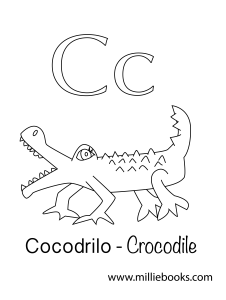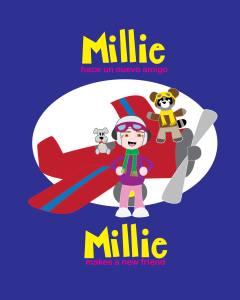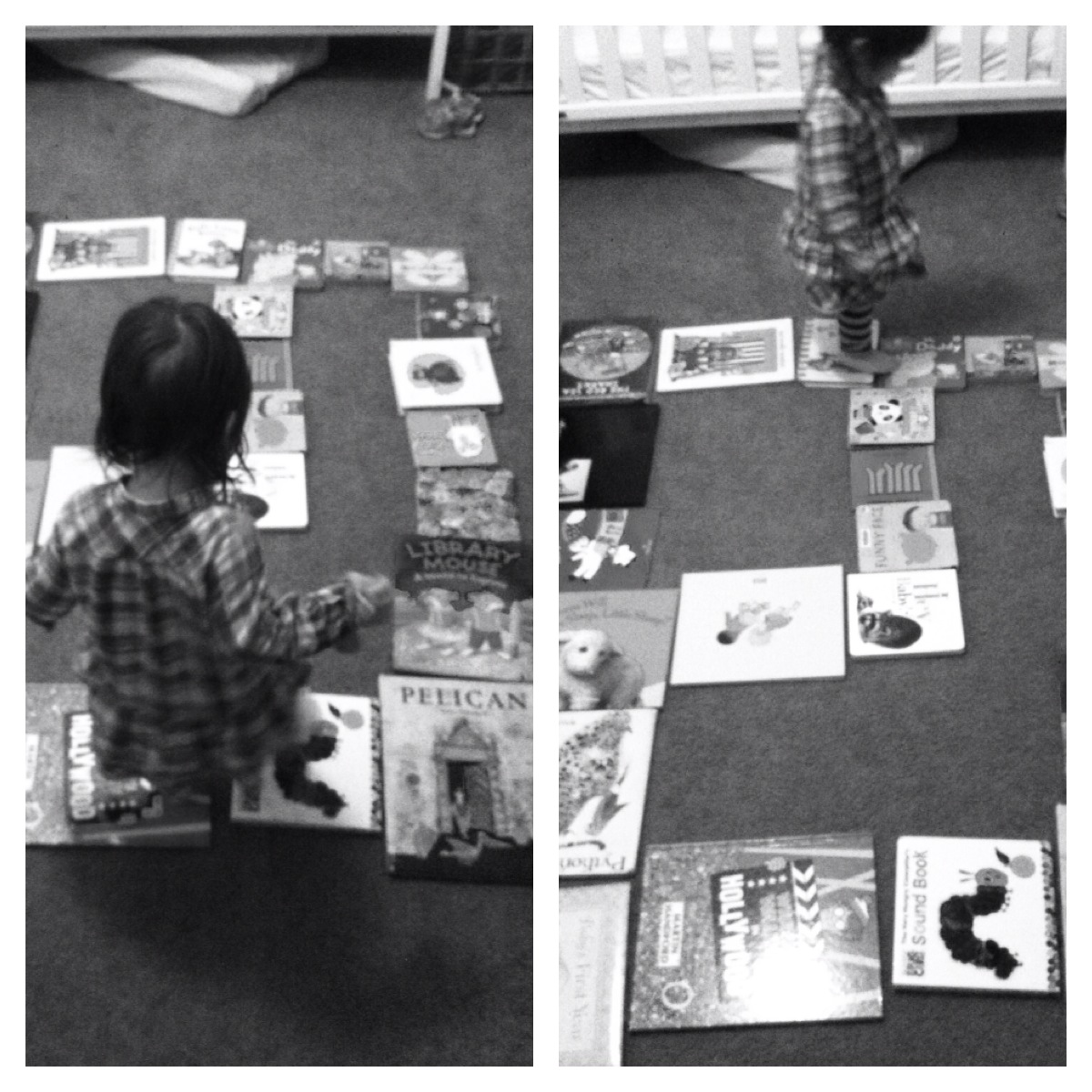En caso de que te estés preguntando cómo es el libro y la historia, aquí leo el libro de Millie hace un nuevo amigo.
Recuerda que también hay disponible una versión bilingüe español-inglés.
¿Qué opinan tus niños? ¡Espero que les guste!
Millie books - Los cuentos de Millie
Reading in two languages - Leyendo en dos idiomas
by Erika Deery
En caso de que te estés preguntando cómo es el libro y la historia, aquí leo el libro de Millie hace un nuevo amigo.
Recuerda que también hay disponible una versión bilingüe español-inglés.
¿Qué opinan tus niños? ¡Espero que les guste!
by Erika Deery
In case you were wondering what the book looks like inside, here I read aloud Millie makes a new friend.
Let me know what you kids think!
by Erika Deery
Hey!
This month I have been posting on Millie’s Facebook page something a little different. I have made a bilingual alphabet colouring pages printable for you.
A few months ago we were given this beautiful alphabet book (in English) as a present for my little girl. She absolutely loves it, however, it was very hard for me to translate to Spanish on the spot because I didn’t know whether to follow the image or the letter. So I got this idea to make my own little animal alphabet, but I didn’t really pay attention to it as I was also working on finishing up Millie makes a new friend. For some reason, this idea kept coming into my head so I decided that I had to do something about it.
 For weeks I kept thinking of the animals with different letters of the alphabet that would be the same in English and Spanish and then finally I came up with a list! Here is where I gave myself a little challenge to post one letter everyday during February. Now that the month is over I just wanted to keep this somewhere as a printable version so you can come back to it any time you need it.
For weeks I kept thinking of the animals with different letters of the alphabet that would be the same in English and Spanish and then finally I came up with a list! Here is where I gave myself a little challenge to post one letter everyday during February. Now that the month is over I just wanted to keep this somewhere as a printable version so you can come back to it any time you need it.
I really hope you and your kid(s) enjoy it as much as I enjoyed making this. Download the printable Bilingual animal alphabet (Spanish-English) and get colouring!
Happy colouring!
by Erika Deery
¡Hola!
Este mes he estado posteando en la página de Facebook de Millie algo un poquito diferente. He creado un alfabeto bilingüe para colorear. Es un PDF que podrás imprimir fácilmente.
Hace unos meses le regalaron un libro del abecedario (en inglés) a mi hija. Le encanta, el libro es súper bonito con las letras cortadas en la forma y colores muy brillantes. Sin embargo, a la hora de leerlo me era muy difícil traducirlo al español ahí mismo porque no sabía si hacerle caso a la letra o al dibujo. Esto me dio la idea de hacer mi propio alfabeto bilingüe inspirado en animales. Al principio no le hice caso a esa idea porque estaba trabajando en terminar Millie hace un nuevo amigo. Pero por alguna razón, esta idea seguía en mi cabeza, así que tenía que hacer algo al respecto.
 Por varias semanas estuve pensando en qué animales y qué letras eran iguales en español y en inglés hasta que finalmente tuve una lista. Aquí es donde me impuse el pequeño reto de postear una letra cada día durante febrero. Ahora que se acaba el mes, solo quería poner todo el abecedario en donde puedas encontrar fácilmente una versión para imprimir cuando la necesites.
Por varias semanas estuve pensando en qué animales y qué letras eran iguales en español y en inglés hasta que finalmente tuve una lista. Aquí es donde me impuse el pequeño reto de postear una letra cada día durante febrero. Ahora que se acaba el mes, solo quería poner todo el abecedario en donde puedas encontrar fácilmente una versión para imprimir cuando la necesites.
Espero que a ti y a tus niños les guste colorearlo tanto como yo me divertí en crearlo. Haz clic y baja gratis el Alfabeto bilingüe de animales (español-inglés) y pónganse a colorear.
¡Que se diviertan!
by Erika Deery
Hola!
Just this week I published the second book of Millie’s adventures. It feels like it has taken forever. I started this in April last year and after what it felt like thousands of edits I was finally happy with it.
This is the second (of hopefully many more) bilingual books for toddlers who speak English and Spanish.
I hope you like it!
Millie makes a new friend is now available on Amazon in English and in bilingual versions. 😀
—
Hello!
Justo esta semana publiqué el segundo libro de las aventuras de Millie. Parece que me ha tomado muchísimo tiempo. Empecé con el libro en abril del año pasado y después de editarlo como mil veces por fin ya estuve contenta con como quedó.
Este es el segundo libro bilingüe (de espero muchos más) para niños y niñas que hablan español e inglés.
¡Espero les guste!
Millie hace un nuevo amigo ya está disponible en Amazon en español y en su versión bilingüe. 😊

by Erika Deery
Todos sabemos que hay muchos libros muy lindos para niños. Pero afrontémoslo, ¡solo puedes leer la Oruga Hambrienta tantas veces sin volverte loco!
Hasta he empezado a notar que a mi bebé le empiezan a aburrir las mismas historias pero se me han ocurrido algunas maneras de mantener las cosas interesantes.
1. Conviértete en un actor. Si todavía no estás haciendo esto…. utiliza diferentes entonaciones y acentos para cada personaje. Sorprende a tu pequeñ@ sacando al actor que llevas dentro. Por ejemplo, si leo Millie a mi bebé, pretendo que el Conejo de la Luna es español y que Kliff y Kloff son chilangos. Cuando leemos’Estofado de Wombat’ ceceo cuando habla la lagartija y pretendo ser una señora elegante cuando la emu le aconseja al dingo como mejorar su estofado. Tal vez te sientas un poquito tonto al principio pero tu bebé no te va a juzgar por tu actuación que no ganará un Oscar.
2. Dile a tu peque que te cuente la historia. Si son lo suficientemente grandes y ya saben hablar, ellos te van a poder contar la historia basándose en los dibujos. Relájate y disfruta ver a tu bebé usar su imaginación. Por otro lado si son mas pequeñitos puedes apuntar y preguntar ‘¿qué es esto?’ para que te vayan diciendo las palabras que conozcan. Otra opción es preguntar’¿dónde está el elefante?’ o’¿dónde está la casa?’. Te sorprenderá que tantas cosas saben.
3. No leas la historia. Enfócate en otras cosas en las ilustraciones, nombra los objetos y relaciónalos con su vida diaria. Por ejemplo, si la oruga se come una manzana, pregúntale a tu bebé qué tanto le gustan las manzanas o si son más grandes, cuál es su tipo o color de manzana favorito.
4. Inscríbete en tu biblioteca local. La mayoría de las ciudades grandes tiene bibliotecas que ofrecen programas para niños. Tú y tu familia podrán disfrutar una gran variedad de libros sin tener que gastar mucho. Otra opción es intercambiar libros con amigos o comprar de segunda mano en algún mercado o por internet.
5. Juega con los libros de diferente manera. Este tip no es sobre leer sino sobre jugar y divertirse con los libros. Pueden construir una torre, ordenarlos o construir un caminito o puente para que tu bebé camine encima de ellos. La idea es mostrarle a tus niños que los libros pueden ser tan divertidos como ellos quieran.
 ¡Espero que estos tips te ayuden a que tu peque se divierta leyendo! Si tienes otros tips que quieres compartir deja tus comentarios en este blog 🙂
¡Espero que estos tips te ayuden a que tu peque se divierta leyendo! Si tienes otros tips que quieres compartir deja tus comentarios en este blog 🙂
by Erika Deery
We all know that there are a lot of beautiful children’s books out there. But let’s face it, you can only read the Hungry Caterpillar so many times!
Even I have noticed that my little one has started to get bored with the same stories, but I have come up with ways to make things a little bit more interesting.
1. Be an actor. If you are not already doing this…. Make voices and entonations, different accents help too. Surprise your little one by getting out your inner actor. For example, if I read the Millie book to my baby I pretend the Rabbit on the Moon is Spanish and that Kliff and Kloff are ‘chilangos’. When I read ‘Wombat stew’ I lisp as the lizard talks and I pretend to be a posh lady when Emu is telling Dingo how to improve his stew. You might feel silly at the beginning but hey, your baby won’t judge you for your non Oscar performance!
2. Ask them to tell you the story. If they are old enough and they are talking, you can ask them to tell you the story based on the pictures. Relax and enjoy! If they are younger though, you may be able to point and ask ‘what is this?’ so they can tell you. Another option is to ask ‘where is the elephant?’ Or ‘where is the house?’. You will be surprised at how much they know!
3. Don’t read the story. Focus on other things in the pictures, name the items and relate them to your life. For example, if the caterpillar ate one apple, say how much your little one loves apples or if they are older, what is their favourite colour of apple?
4. Join your local library. We are spoilt in Australia on this one. However, if you live elsewhere Google will tell you if there are any libraries near you. Nowadays, local libraries have a lot of programs for kids and you and your family will enjoy more variety without going through the expense of buying new books. Alternatively, you can swap books with friends or buy them second hand at a local market or on Amazon.
5. Use books in a different way. This one is not so much about reading but about playing with books. You can stack them, sort them, build a ‘bridge’ for your baby to walk over them as an obstacle course. The idea here is to let your kids know books can be fun.

I hope these tips help you in making your and your toddler’s reading experience a little better. Do you have any other tips you would like to share? Leave us your comments below! 🙂